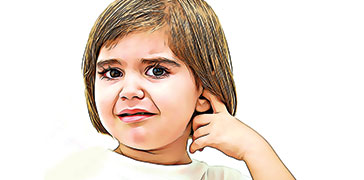US Pharm. 2023;48(8):15-16.

Leading Cause of Pediatric Doctor Visits
Otitis media (OM) is an ear infection caused by viruses or bacteria that infect the ear, usually after contracting a cold or other illness. It is called OM because it affects the middle ear, behind the tympanic membrane (eardrum). OM is one of the most common illnesses for which antibiotics are prescribed in children and is frequently the cause of hearing loss in childhood. OM is most prevalent in children aged 6 to 24 months because their immune systems are immature and their eustachian tubes are shorter and more horizontal than adults, accumulating fluids and infections.
Some Children Are Genetically Predisposed
Approximately 80% of children in the United States will have an occurrence of OM before reaching school age. Children assigned male at birth are more prone to developing OM than those assigned female. The presence of allergies, daycare attendance, and second-hand smoke exposure are risk factors for developing OM. In addition to these physical and environmental risk factors, some children may be genetically predisposed to the illness.
It has been shown that breastfed children have a decreased incidence of OM compared with children who feed from a bottle while lying down. The use of pacifiers increases the incidence of OM.
Symptoms of acute OM include sudden onset of ear pain, swelling, redness inside the ear, and trouble hearing. Some children with ear infections are too young to accurately express what they are feeling. Instead, they may have trouble sleeping or cry more than usual, similar to a child with colic. However, with an ear infection, the child also has signs that point to ear involvement, such as loss of balance, trouble hearing (e.g., not responding to quiet sounds or whispered words), or fluid draining out of the ears. The child may also tug or pull at the ear.
A physician is required for the effective diagnosis and management of OM. Along with an assessment of signs and symptoms, the doctor may use a special otoscope to view and evaluate the mobility of the eardrum. Bulging, reduced movement, swelling, or redness of the tympanic membrane points to acute OM diagnosis. Next, the physician will work to determine the cause of the illness and begin appropriate treatment.
Antibiotics Are Used With Caution
Antibiotics will be prescribed if the cause is thought to be due to bacteria. High-dose oral amoxicillin is usually the first choice for children aged younger than 2 years without a penicillin allergy. Because many cases of OM resolve on their own, antibiotics are reserved for severe OM in one ear or OM that is present in both ears. Some acute episodes result in a perforation of the eardrum. In that case, topical antibiotics like ofloxacin can be given in the ear.
If given antibiotics, the entire course of antibiotics must be taken, even if the child stops complaining of the pain after a few days and seems better. Stopping the antibiotics too soon can allow the infection to return and contribute to antibiotic resistance. However, if the ear infection is due to viruses, antibiotics are ineffective.
Hearing and Language Development Can Suffer
The child’s hearing can suffer if OM goes on too long. Long-term infection leads to an inability of the tympanic membrane and middle ear bones to vibrate normally. Eventually, speech and language are affected. Normal hearing allows children to interpret everyday speech and imitate it as language and speaking skills evolve.
Acute OM becomes chronic if three acute episodes are experienced in 6 months or four in 12 months. According to the American Academy of Pediatrics guidelines, those who have experienced four or more episodes of acute OM in the past 12 months should be considered candidates for myringotomy with tube placement. Myringotomy is a slit created in the eardrum (tympanic membrane) to allow fluid to drain out of the middle ear. A tube can be placed in the slit to allow for continuous drainage over a long period of time.
The content contained in this article is for informational purposes only. The content is not intended to be a substitute for professional advice. Reliance on any information provided in this article is solely at your own risk.
To comment on this article, contact rdavidson@uspharmacist.com.





